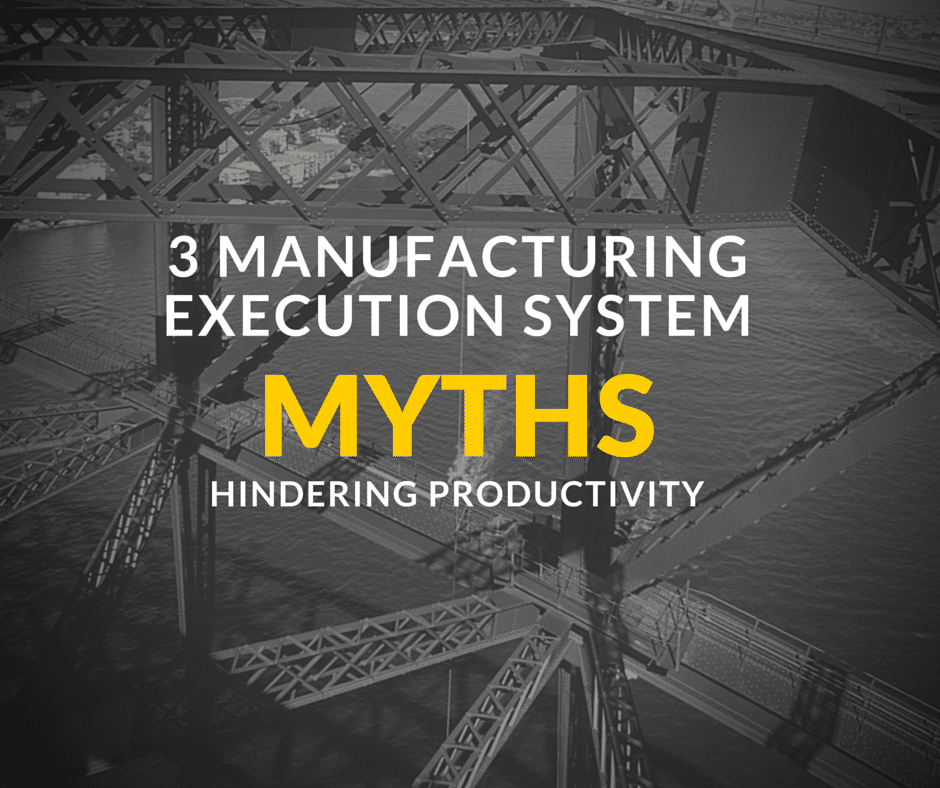 In order to stay competitive in today’s fast-paced manufacturing industry, manufacturers must evolve beyond simply tracking defects, failures, and corrections, and start integrating quality management practices that prevent errors. To do this effectively companies must incorporate a Manufacturing Execution System (MES) into their current operations. Unfortunately, we often hear executives and managers resist the need to implement such a system, listing an array of reasons as to why they feel it is not necessary.
In order to stay competitive in today’s fast-paced manufacturing industry, manufacturers must evolve beyond simply tracking defects, failures, and corrections, and start integrating quality management practices that prevent errors. To do this effectively companies must incorporate a Manufacturing Execution System (MES) into their current operations. Unfortunately, we often hear executives and managers resist the need to implement such a system, listing an array of reasons as to why they feel it is not necessary.
In order to help encourage such managers and improve manufacturing processes across all complex manufacturing industries, we’ve summarized here the top 3 common myths about MES.
Myth 1: “We can create a better manufacturing execution system on our own.”
The struggles of teams developing and maintaining custom home-grown systems is well documented by industry analysts and manufacturers that eventually moved to commercial-off-the-shelf (COTS) solutions. Creating a manufacturing execution system in-house all but ensures the team will deviate from their core manufacturing and IT competencies into software development and maintenance, both which require huge investments into technology and skills to keep the application working. Resources and costs will now be diverted towards developing and maintaining the solution rather than focusing on the fundamental manufacturing practice.
Upgrades often become extremely difficult to implement because homegrown solutions are highly customized solutions without necessarily a lot of thought into long term architecture and scalability strategy. Often custom solutions from different divisions might be boot-strapped together. Because each custom system was designed separately on different platforms, upgrades to one system can easily break the loose connections in place between them. Data might not flow from one system to the next very smoothly with inconsistency in naming conventions, data lengths and units of measure.requiring hours of custom coding translations.
Support of a homegrown solution limits domain knowledge to the developers that coded the solution in the first place. Losing key developers means increased risk of downtime when a homegrown solution encounters an error. After a few years, the development team might turn into one person with questionable health. Commercial MES software vendors have an entire organization set up to support their customers including 24/7 support teams, documentation, and deep application knowledge spread amongst a variety of people to ensure smooth implementations and troubleshooting.
Bottom-line, the products you’re building are complex, and your system requirements are also complex. There is no need to turn your management tools into a complex endeavor also. Instead rely on commercial experts with years of manufacturing and software development experience under their belts. A well-engineered out-of-the-box manufacturing software solution can prove its benefit immediately. Your MES partner and their MES user community can turn into long term partners for your organization.
Myth 2: “It costs too much to purchase a manufacturing execution system. It’s not worth the money.”
Industry analysts including Gartner Research [1] have well documented the return on investment (ROI) from MES implementations for many companies in a wide range of industries. It is typical the an MES system investment pays for itself in less than a year by just addressing the cost of operating with pen and paper and dated legacy paper-based solutions . Paper based manufacturing solutions and siloed legacy systems are riddled with waste and inefficiency. Assessing the opportunity cost of poor quality vs. implementing a best in class manufacturing execution should yield plenty of benefits relative to the costs. Implementing such solutions can eliminate costly rework, scrap and delays by alerting your team as issues occur.
Quality professionals must consider how to best troubleshoot and control potentially problematic manufacturing processes to ensure acceptable quality at the end. While m any can be paralized by the investment and effort of acquiring an MES, experts know to look beyond the initial investment, considering the time and money that will ultimately be gained by incorporating such a system. A simple way to assess the value in such a tool is to walk through typical use cases and perform an ROI analysis with the vendor.
Myth 3: “It’s just another system to manage.”
We know IT already has to manage enough systems and ensure their operability. Some view manufacturing execution systems as just another item in a long list to support. This can be true if the system you decide to purchase is not compatible with the others you have in place. Newer “MES systems” integrate execution, enterprise quality management, and aftermarket service platforms throughout the manufacturing process to focus on preventive practices. The added breadth of the functionality on an enterprise level can consolidate numerous systems together by becoming a one-stop-shop also eliminating many spreadsheets or databases around the shop. Many MES also offer ready integrations to common PLM and ERP systems. Moving operations to a broad and more robust solution should help relieve IT’s bandwidth by reducing the number of systems to manage.
Conclusion:
For first-time MES buyers, the idea of implementing a software solution for the manufacturing process can seem like a daunting task. And, depending on which provider you decide to pursue, it very well may be an excruciating experience. To understand how an MES benefits complex manufacturing, download our eBook, What is MES, to get your foot in the door.
Reference:
[1] “Get the Most Out of Digital Manufacturing by Extending the Value of Your Manufacturing Execution System”, Rick Franzosa, Gartner, February 2016



